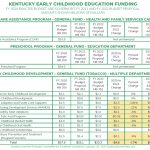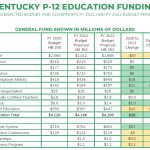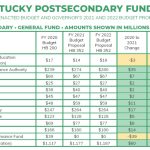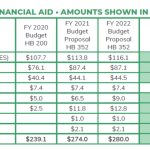We are pleased to see the commitment by the Governor to make strides that stem the erosion of education funding in the face of significant budget challenges.
Based on $1.256 billion in additional resources over the biennium, major elements of the Governor’s proposed budget include: investments to fully fund pensions, a $2,000 raise for school teachers, restoration of textbook funding, a 1% increase in the base SEEK per-pupil guarantee, increasing the base funding to colleges and universities, and increasing student financial aid continuing a commitment to allocate 100% of lottery proceeds to scholarships.
These are all positive steps. However, we remain concerned by the lack of investment in other critical programs that support teaching a learning – from early childhood through postsecondary.
Early childhood
Achieving high-quality early learning opportunities for all children requires additional investment – investment we cannot fully see in the Governor’s proposal. This is critical when almost 50% of our children enter kindergarten not ready to learn, and 50% of Kentucky families live in a childcare desert where quality childcare is either non-existent or unaffordable for working parents.
- Public Preschool – The Governor indicated an additional $5 million each year to support preschool on disadvantaged areas, although we cannot see this total investment in the budget bill as filed. Our Big Bold Ask was for $24 million over the biennium to begin phasing in investment for eligibility up to 200% of the federal poverty level, higher per-child rates to support quality programs, and continue support for preschool/childcare partnership grants to support families with full-day learning opportunities for kids.
- Child Care Assistance Program (CCAP) – The Governor’s proposal appears to provide no additional funds to support CCAP. Our Big Bold Ask was for $92 million over the biennium to begin phasing in investment for eligibility up to 200% of the federal poverty level, as well as higher reimbursement rates to support quality programs – for infants, toddlers, and preschool age children.
A critical concern is a $2 million cut in tobacco settlement dollars to the HANDS early home visiting program. HANDS provides critical supports to improve pregnancy and birth outcomes, promote
healthy child development, build safe homes, and increase families’ self-sufficiency.

Child Care Assistance Program Note
The $10.6 million in General Fund revenue appropriated in the FY 2020 budget allows additional children to receive child care assistance by raising the eligibility requirements to include families with incomes of up to 160% of the federal poverty level. CCAP is largely funded by federal dollars not shown here, in addition to state General Fund and Tobacco Settlement dollars. State regulation 922 KAR 2:160 now establishes eligibility for CCAP at 160% of the federal poverty level. Funding for the Division of Child Care in the 2020-2022 Executive Budget released by the Office of the State Budget Director indicates flat funding over the biennium – $26.3 million in each year – which is the same level as the current year.
Preschool Note
The 2020-2022 Executive Budget released by the Office of the State Budget Director includes this note “An additional $5 million each year from the General Fund is included to support preschool programs in disadvantaged areas. This funding is intended to create more opportunities for children in the most need to obtain the benefits of preschool programs. Moreover, the Executive Budget includes provisions that would direct any excess funds from the SEEK formula and the actual lottery funds greater than estimated to the preschool programs administered by the Department of Education.” Future editions of the budget bill are likely to show the total being appropriated for preschool.
HANDS Program Note
The $9 million appropriated for the HANDS program in the FY 2020 budget provided our state share of qualifying funds to participate in the federal Maternal, Infant, and Early Childhood Home Visiting Program (MIECHV). As the budget process continues, it will be important to analyze how lowering that funding to $7 million will affect Kentucky’s eligibility for federal MIECHV support and continue to offer services at a level necessary to support new families.
Early Childhood Scholarships Note
Early childhood scholarships were an important component of Kentucky’s early childhood development in years past. In more recent years, the scholarships have been left out of tobacco-funded early childhood investment plans. Limited funding for early childhood scholarships is currently being provided using by KHEAA using carry forward and restricted funds.
K-12
To deliver excellence for every Kentucky child in our public school system, Kentucky must restore investments after years of cuts and lost buying power. Gov. Behear stated as much and began this by providing some strategic investment – namely in the form a $2,000 raise for school teachers, teacher scholarships, and restoration of textbook funding. The base SEEK per-pupil guarantee was increased 1%, but this may largely be paid for by local dollars. Kentucky still needs deeper investment to support teaching and learning at the local level.
- Full-Day Kindergarten – This was not in the Governor’s proposal, except for language indicating excess lottery proceeds can be used to support. Our Big Bold Ask was for $42 million over the biennium to begin phasing in investment for full-day kindergarten – freeing local funds for teaching and learning improvements.
- Transportation – The Governor provide no new funds for school transportation, underfunding the transportation formula as has been the practice for a number of years. Our Big Bold Ask was for $48.6 million over the biennium to begin phasing in investment for transportation – freeing local funds for teaching and learning improvements.
- Teaching Excellence – Increasing teacher compensation is certainly a positive as teachers matter most to student learning in the classroom – and the Governor provides $164 million over the biennium to support the $2,000 increase. However, in addition to increases in base salary, Kentucky must invest in systematic state support for teacher preparation, professional development, and recruitment and retention. Our Big Bold Ask was for $17.5 million over the biennium to invest such supports like teacher mentorship, greater stipends for National Board Certified Teachers, and district/university partnerships to innovate teacher preparations and professional learning

Teacher Salary Increase Note
The 2020-2022 Executive Budget released by the Office of the State Budget Director includes this note: “The Executive Budget includes General Fund in the amount of $85,266,700 in fiscal year 2021 and $79,298,000 in fiscal year 2022 to fund cost increases associated with $2,000 teacher salary increases.” House Bill 352 calls explicitly for the $2,000 salary increases, but does not state a total cost for those increases. HB 352 also identifies $50,800,000 in unexpended SEEK funds appropriated in FY 2020 to be used to pay part of the FY 2021 costs of those salary increases.
Textbook Note
HB 352 identifies $17 million in unexpended SEEK funds appropriated in FY 2020 to be used to fund textbook spending of $8.5 million in FY 2021 and $8.5 million in FY 2021.
POSTSECONDARY
Kentucky’s Council on Postsecondary Education has set an attainment goal of 60% by 2030, while economic projections suggest that the supply of workers with postsecondary education continues to fall short of the demand for an educated workforce. To reach our goals, we must break down barriers to college access, ensure higher education is affordable, and support student success. The Governor’s proposal stems the cycle of funding reductions to our colleges and universities – 33% since 2008 – and fully commits proceeds from the state lottery to student financial aid.
- Colleges and Universities – The Governor proposes a 1% increase in base funding ($8.6 million per year) to restore a portion of prior cuts and provides $18.7 million each year to provide pension relief to regional campuses and KCTCS. Of significance, no funds will be allocated through the performance funding model adopted in 2017. While restoring base funding and stabilizing investments are critical, it is equally critical that Kentucky find a way to invest enough to make performance funding work as intended. Our Big Bold Ask was for $93 million over the biennium to begin phasing in investment to fully implement the performance funding model.
- Need-Based Financial Aid – With lottery receipts projected to rise and the promise to commit all lottery proceeds scholarships, this is a bright spot in the budget. The Governor proposes $22 million over the biennium for College Access Program grants for low-income students. Our Big Bold Ask was for $8.9 million over the biennium to begin phasing in investment in CAP grants. Not only will CAP grants see and increase, but also other critical financial aid programs such as KEES, KTG, Dual Credit, and Work Ready scholarships.
The Governor’s budget proposal was a step forward but still sobering – highlighting the fact that new revenue is necessary to ensure Kentucky’s investment in education provides the return we know it can. Without continued progress in education Kentucky’s quality of life and economic growth will suffer.
We’ve hit a plateau in education progress, declining in the last decade relative to national rankings on more indicators than we are showing progress.
- 41st in preschool participation – down from 24th
- 17th in fourth grade reading – down from 8th
- 37th in eighth grade math – down from 34th
- 26th in teacher salaries – down from 22nd
- 30th in per-pupil finding for higher education – down from 12th
Moreover, only 52.7% of Kentucky’s 3rd graders are proficient in reading and only 47.4% in mathematics. Only 64.8% of Kentucky’s high school graduates are transition ready. And, we lag the nation in postsecondary attainment.

Postsecondary Funding Note
Funding for colleges and universities includes a 1% increase in base funding inclusive of performance-based funding allocations in 2020. Additional funds were included for regional universities and KCTCS to off-set increased pension obligations. No additional funds were provided to be allocated through the Performance Funding Model adopted in 2017. The Governor’s proposed budget incudes line-items for “mandated programs” for each campus, but does not indicate what those programs are. The Governor’s proposed budget includes General Fund in the amount of $4.1 million 2021 and $12.4 million in 2022 for debt service for capital projects requiring a 50% match from postsecondary institutions. The amounts shown above are net of debt service for capital projects.


Lottery Revenue Note
100% of net lottery proceeds are being committed to student financial aid. The Consensus Forecasting Group’s official estimates were $277 million in 2021 and $283 million in 2022. By statute, $3 million is deducted “off the top” for the Collaborative Center for Literacy Development and the Reading Diagnostic & Intervention Fund. The full amount of net proceeds equaling $274 million in 2021 and $280 million in 2022 are appropriated to student financial as indicated above.
KEES Note
KEES funding above reflects the General Fund portion only from lottery receipts. Total funding is $123.8 million in 2021 and $126.1 million in 2022 when including restricted funds appropriation of $10 million in each year from unclaimed lottery prizes.
It’s time to build on our past success and increase our progress for the future. Combined with the ambitious goals, a commitment to adequate and equitable funding for education will ensure we meet those goals.
We are not investing in a vacuum. Other states are increasing their investment from early childhood through postsecondary, recognizing their human capital as the primary economic engine of a state and the imperative to support a seamless web of educational opportunities necessary for success in school, career and life.
We are encouraged that the Governor delivered a budget that stems a decade of funding reductions and begins to reinvest in some areas of education. We urge the General Assembly and the Governor to continue the hard decisions necessary to follow through on tax reform that results in revenue necessary to further increase our investment in Kentucky’s people.
For detailed analysis of the budget as it moves through the legislative process please visit the Prichard Blog.





Comments are closed.